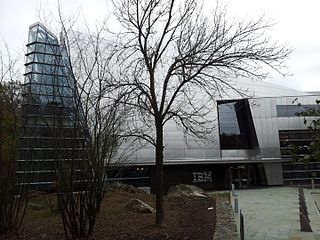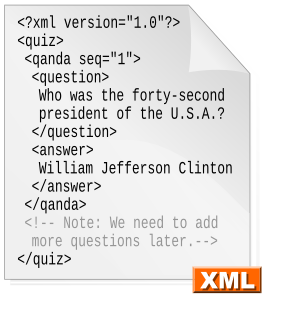Overview
In particular, GXL was developed to enable interoperability between software reengineering tools and components, such as code extractors (parsers), analyzers and visualizers. GXL allows software reengineers to combine single-purpose tools especially for parsing, source code extraction, architecture recovery, data flow analysis, pointer analysis, program slicing, query techniques, source code visualization, object recovery, restructuring, refactoring, remodularization, etc., into a single powerful reengineering workbench.
There are two innovative features in GXL that make it well-suited to an exchange format for software data.
- The conceptual data model is a typed, attributed, directed graph. This is not to say that all software data ought to be manipulated as graphs, but rather that they can be exchanged as graphs.
- It can be used to represent instance data as well as schemas for describing the structure of the data. Moreover, the schema can be explicitly stated along with instance data. The structure of graphs exchanged by GXL streams is given by a schema represented as a Unified Modeling Language (UML) class diagram.
Since GXL is a general graph exchange format, it can also be used to interchange any graph-based data, including models between computer-aided software engineering (CASE) tools, data between graph transformation systems, or graph visualization tools. GXL includes support for hypergraphs and hierarchical graphs, and can be extended to support other types of graphs.

Computer-aided software engineering (CASE) is the domain of software tools used to design and implement applications. CASE tools are similar to and were partly inspired by computer-aided design (CAD) tools used for designing hardware products. CASE tools are used for developing high-quality, defect-free, and maintainable software. CASE software is often associated with methods for the development of information systems together with automated tools that can be used in the software development process.
In computer science, graph transformation, or graph rewriting, concerns the technique of creating a new graph out of an original graph algorithmically. It has numerous applications, ranging from software engineering to layout algorithms and picture generation.

In mathematics, a hypergraph is a generalization of a graph in which an edge can join any number of vertices. Formally, a hypergraph is a pair where is a set of elements called nodes or vertices, and is a set of non-empty subsets of called hyperedges or edges. Therefore, is a subset of , where is the power set of .
GXL originated in the merger of GRAph eXchange format (GraX: University of Koblenz, DE) for exchanging typed, attributed, ordered, directed graphs (TGraphs), Tuple Attribute Language (TA: University of Waterloo, CA), and the graph format of the PROGRES graph rewriting system (University Bw München, DE). Furthermore, GXL includes ideas from exchange formats from reverse engineering, including Relation Partition Algebra (RPA: Philips Research Eindhoven, NL) and Rigi Standard Format (RSF: University of Victoria, CA). The development of GXL was also influenced by various formats used in graph drawing (e.g. daVinci, Graph Modelling Language (GML), Graphlet, GraphXML) and current discussions on exchange formats for graph transformation systems.
Graph Modeling Language (GML) is a hierarchical ASCII-based file format for describing graphs. It has been also named Graph Meta Language.
At the 2000 International Conference on Software Engineering (ICSE 2000) Workshop on Standard Exchange Formats (WoSEF), GXL was accepted as working draft for an exchange format by numerous research groups working in the domain of software reengineering and graph transformation.
The International Conference on Software Engineering (ICSE), is one of the largest annual software engineering conferences. It has an 'A*' rating in the Rankings of the Computing Research and Education Association of Australasia (CORE) and an 'A1' rating from the Brazilian ministry of education. Furthermore, it is the software engineering conference with the highest Microsoft Academic field rating. The first ICSE conference was in 1975 in Washington DC.
During the APPLIGRAPH Subgroup Meeting on Exchange Formats for Graph Transformation, an overview of GXL was given [Schürr, 2000] and participants decided to use GXL to represent graphs within their exchange format for graph transformation systems (GTXL).
The 2000 IBM Centers for Advanced Studies Conference (CASCON 2000) included two half-day workshops on GXL. In the morning, 'Software Data Interchange with GXL: Introduction and Tutorial' gave a primer on the syntax and concepts in the format, while the afternoon workshop, 'Software Data Interchange with GXL: Implementation Issues' discussed the development of converters and standard schemas.

International Business Machines Corporation (IBM) is an American multinational information technology company headquartered in Armonk, New York, with operations in over 170 countries. The company began in 1911, founded in Endicott, New York, as the Computing-Tabulating-Recording Company (CTR) and was renamed "International Business Machines" in 1924.
CASCON is a Computer Science conference hosted by IBM Canada Software Lab. CAS Research that occurs annually in late-October or early-November in Markham, Ontario. The conference typically lasts 3 or 4 days.
At the Seventh Working Conference on Reverse Engineering (WCRE 2000), GXL was presented in a tutorial [Holt et al., 2000] and during the workshop on exchange formats [Holt/Winter, 2000]. Central results were a simpler representation of ordering information, the usage of UML class diagrams to present graph schemata and the representation of UML class diagrams by GXL graphs.
The Dagstuhl Seminar on Interoperability of Reengineering Tools ratified GXL 1.0 as a standard interchange format for exchanging reengineering related data. Numerous groups from industry and research committed to using GXL, to import and export GXL documents to their tools, and to write various GXL tools.

Dia
is free and open source general-purpose diagramming software, developed originally by Alexander Larsson. Dia uses a controlled single document interface (SDI) similar to GIMP and Inkscape.

The Unified Modeling Language (UML) is a general-purpose, developmental, modeling language in the field of software engineering that is intended to provide a standard way to visualize the design of a system.
The XML Metadata Interchange (XMI) is an Object Management Group (OMG) standard for exchanging metadata information via Extensible Markup Language (XML).

In computing, UML eXchange Format (UXF) is a XML-based model interchange format for Unified Modeling Language (UML), which is a standard software modeling language. UXF is a structured format described in 1998 and intended to encode, publish, access and exchange UML models.
Model-driven architecture (MDA) is a software design approach for the development of software systems. It provides a set of guidelines for the structuring of specifications, which are expressed as models. Model-driven architecture is a kind of domain engineering, and supports model-driven engineering of software systems. It was launched by the Object Management Group (OMG) in 2001.
The Object Constraint Language (OCL) is a declarative language describing rules applying to Unified Modeling Language (UML) models developed at IBM and is now part of the UML standard. Initially, OCL was merely a formal specification language extension for UML. OCL may now be used with any Meta-Object Facility (MOF) Object Management Group (OMG) meta-model, including UML. The Object Constraint Language is a precise text language that provides constraint and object query expressions on any MOF model or meta-model that cannot otherwise be expressed by diagrammatic notation. OCL is a key component of the new OMG standard recommendation for transforming models, the Queries/Views/Transformations (QVT) specification.
Round-trip engineering (RTE) is a functionality of software development tools that synchronizes two or more related software artifacts, such as, source code, models, configuration files, and even documentation. The need for round-trip engineering arises when the same information is present in multiple artifacts and therefore an inconsistency may occur if not all artifacts are consistently updated to reflect a given change. For example, some piece of information was added to/changed in only one artifact and, as a result, it became missing in/inconsistent with the other artifacts.
The common warehouse metamodel (CWM) defines a specification for modeling metadata for relational, non-relational, multi-dimensional, and most other objects found in a data warehousing environment. The specification is released and owned by the Object Management Group, which also claims a trademark in the use of "CWM".
A UML tool or Unified Modeling Language tool is a software application that supports some or all of the notation and semantics associated with the Unified Modeling Language (UML), which is the industry standard general-purpose modeling language for software engineering.
Software visualization or software visualisation refers to the visualization of information of and related to software systems—either the architecture of its source code or metrics of their runtime behavior- and their development process by means of static, interactive or animated 2-D or 3-D visual representations of their structure, execution, behavior, and evolution.
In electric power transmission and distribution, the Common Information Model (CIM), a standard developed by the electric power industry that has been officially adopted by the International Electrotechnical Commission (IEC), aims to allow application software to exchange information about an electrical network.
Rigi is an interactive graph editor tool for software reverse engineering using the white box method, i.e. necessitating source code, thus it is mainly aimed at program comprehension. Rigi is distributed by its main author, Hausi A. Müller and the Rigi research group at the University of Victoria.
The Bauhaus project is a software research project collaboration among the University of Stuttgart, the University of Bremen, and a commercial spin-off company Axivion formerly called Bauhaus Software Technologies. The Bauhaus project serves the fields of software maintenance and software reengineering.
Data exchange is the process of taking data structured under a source schema and transforming it into data structured under a target schema, so that the target data is an accurate representation of the source data. Data exchange allows data to be shared between different computer programs.
TransXChange is a UK national XML based data standard for the interchange of bus route and timetable information between bus operators, the Vehicle and Operator Services Agency, local authorities and passenger transport executives, and others involved in the provision of passenger information.

UModel is a UML software modeling tool from Altova, the creator of XMLSpy. UModel supports all 14 UML 2 diagram types and adds a unique diagram for modeling XML Schemas in UML. UModel also supports SysML for embedded system developers, and business process modeling for enterprise analysts. UModel includes code engineering functionality including code generation in Java, C#, and Visual Basic, reverse engineering of existing applications, and round-trip engineering.

Moose is a free and open source platform for software and data analysis built in Pharo.

RIF/ReqIF is an XML file format that can be used to exchange requirements, along with its associated metadata, between software tools from different vendors. The requirements exchange format also defines a workflow for transmitting the status of requirements between partners. Although developed in the automotive industry, ReqIF is suitable for lossless exchange of requirements in any industry.

Sparx Systems Enterprise Architect is a visual modeling and design tool based on the OMG UML. The platform supports: the design and construction of software systems; modeling business processes; and modeling industry based domains. It is used by businesses and organizations to not only model the architecture of their systems, but to process the implementation of these models across the full application development life-cycle.










